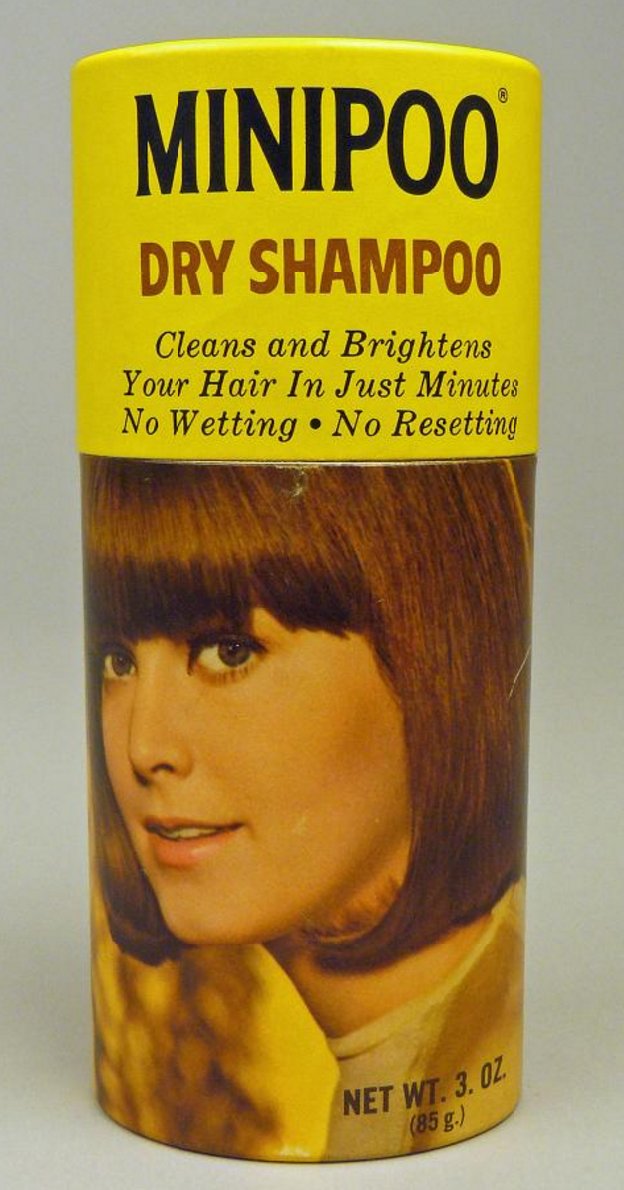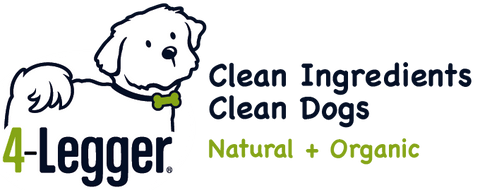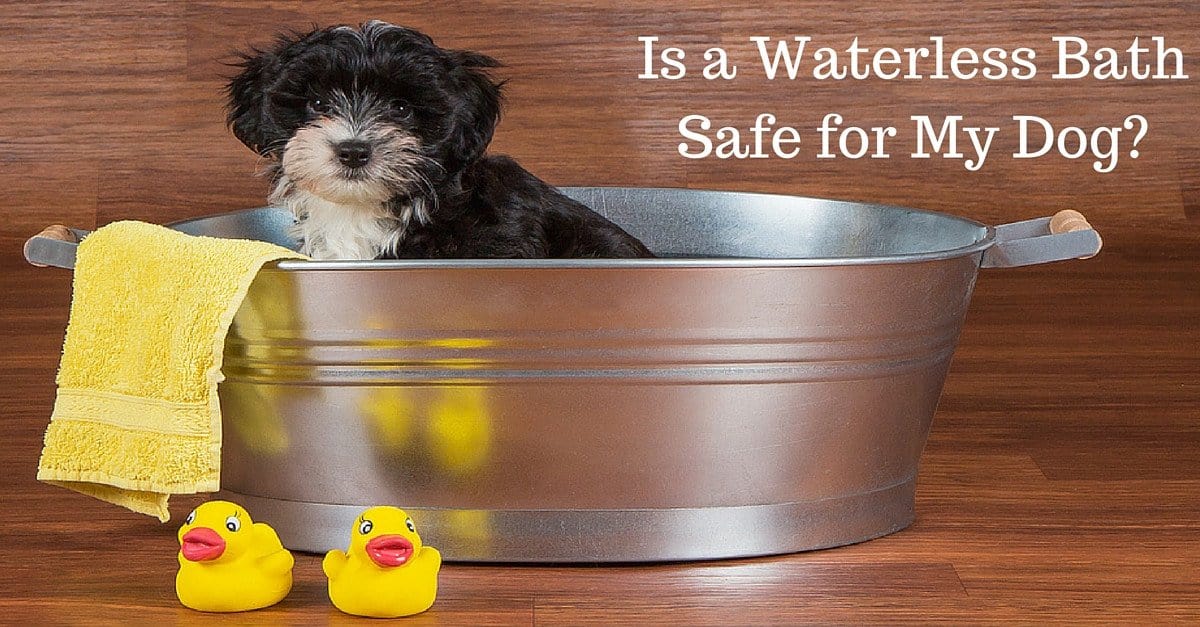A Bath Without Water = A Dog Covered In Environmental Toxins
There has been an influx of waterless (also called dry) dog shampoos into the pet market in the past few years. They are available in liquids, powders, sprays, foams, and gels.
For humans, dry shampoo isn't new. They are first seen in Asia during the 15th century. In the United States, they are first seen in the late 1700s where they were used to deodorize wigs. In the late 1940s they again surged in popularity but this time were used on human heads, not wigs.
The idea was simple - the skin produces sebum, a fatty acid oil that keeps the skin healthy and well moisturized. Between washing, the sebum can build up, leaving greasy, dull, unclean looking hair. Dry shampoos, made of starch powders and clay (Fuller’s Earth), simply absorbed the excess oil on the scalp and hair, so that hair appears to have more body and volume.
 Minipoo, a very popular dry shampoo in the 1960s to 1970s consisted of talc and magnesium carbonate.
Minipoo, a very popular dry shampoo in the 1960s to 1970s consisted of talc and magnesium carbonate.
Unfortunately many of Minipoo's competitors during this era also included asbestos as an ingredient!
In the 1970s, the ingredients, formulations, and delivery mechanisms morphed. While there were some safe and non-toxic starch powders, the trend was aerosol cans with alcohol bases, artificial fragrances, artificial colors, and other synthetic ingredients.
So, aside from Minipoo now being a nickname for the minature poodle how do dry shampoos for humans translate to your dog? Sadly, for the most part it looks like the 1970s all over again.
Some background: Your dog's sebaceous glands are present in large numbers near the paws, back of the neck, rump, chin, and tail area. The sebum gives your dog their distinct smell and is responsible for keeping the skin soft and moist and for making the coat shine. Sebum also has natural antibiotic properties.
The safer dry dog shampoo use starch powders to absorb the excess oils from your dog's coat. Note the stressing of the word excess. You do not want to absorb all of the oils in your dogs coat. The oils are important for healthy skin and coat. Dirt and pollution accumulate naturally on a daily basis and need to be removed from the skin and scalp with a proper bath so the follicle remains clear, balanced, breathing and growing.
Consistent use of dry shampoo on your dog could absorb more than the excess oils and contribute to clogging hair follicles which may contribute to stunted hair growth. The skin is the largest organ in your dog's body. It protects the internal organs from injury, is the most important defense against infections, and is the first line of defense against environmental toxins. Dry shampoo does not remove the environmental toxins your dog has picked up - it simply adds more gunk to your dog's coat and skin.
Let's take a look at some of the newer waterless products for dogs.
At random, we pulled two of the top selling waterless dog grooming products and looked at the ingredients label.
The first product made a claim so vague that there was no way to determine what was actually in the bottle. This shampoo stated that it was "all natural" as well as “safe and non-toxic” with this listed as the ingredients:
“[Product Name] is made with a proprietary blend of botanical extracts and plant proteins for natural cleaning and conditioning”
We see nothing that validates the claims of natural, safe, or non-toxic. Plant proteins are not the same thing as starch powders - we'll revisit this again. What we do see is that the manufacturer doesn't want to list their ingredients.
Waterless Bath Foam Dog Shampoo:
The second product was a waterless bath foam advertised as an anti-static, stress-free formula that repels dirt and leaves no sticky residue. Mumbo jumbo.
Online reviewers of this product remarked that it was a “great new invention” - as you didn’t have to give your dog a real bath - just rub this foam on them and they are good to go!
We found the list of ingredients on the manufacturer website (they were not listed on the bottle): Purified water, coconut based surfactants, glycerin, ethanol, hydrolyzed silk protein, chamomile extract, sea kelp extract, xanthan gum, fragrance, DMDM-Hydantoin, tetrasodium EDTA, titanium dioxide and Mica, FD&C Blue #1.
For the most part it looks like a traditional, use-with-water shampoo except that it also has ethanol added.
Let's break down each ingredient and evaluate it for safety.
| Purified Water | Water in the waterless foam *Chuckle* |
| Coconut Based Surfactants | This is so vague it is hard to know the actual ingredient. It is very likely one of the sulfates - known irritants that can cause redness, dryness, and itching. During processing, these "coconut based surfactants" can be contaminated with ethylene oxide or 1,4-dioxane- both known cancer causing agents. California’s Proposition 65 list of chemicals known or suspected to cause cancer or birth defects includes 1,4-dioxane. The EPA has listed 1,4-dioxane as a likely human carcinogen, with the potential to cause nasal and liver tumors. Noncarcinogenic effects of dioxane include deficits in the nervous system, liver, and kidney. Dioxane can also enter our environment through waste streams such as wastewater treatment plants and landfills as well as manufacturer waste streams. As a note - there are no regulations that ensure the safety of these ingredients and while not all grooming products will be contaminated with 1,4-dioxane, do you want an ingredient on your dog that is known to cause dry skin or worse? |
| Glycerin | Glycerin is a humectant, meaning it attracts moisture to your skin. Glycerin is a natural by-product of the process of saponification (soapmaking). Many commercial manufacturers remove the glycerin and sell it to be used in other products (as in this product) and then sell their low quality soap with a lower percentage of glycerin. High quality shampoos (like 4-Legger) will retain the glycerin in the natural product. |
| Ethanol | Alcohol is the primary ingredient that makes this formulation “waterless” as the product is intended to evaporate when exposed to the air. Ethanol will dry your pet's skin and increase the skins absorption - meaning if ethanol is present - it is easier for toxic ingredients in that product to enter through your dog's skin to their internal organs. |
| Hydrolyzed Silk Protein |
Hydrolysis is a decomposition reaction where you break apart a larger molecule (in this case silk) using a molecule of water. The protein is broken down so it can be absorbed by the hair. Here is where it gets a little tricky. Your dog's coat is primarily made out of chains of protein. Nutrition, health and other factors can affect the health of these proteins. Hydrolyzed silk protein will temporarily be absorbed by the hair/fur to strengthen it IF it is applied with heat. Hot water may be sufficient for some absorption. The heat swells the hair follicles open, allowing the silk protein to be absorbed. If the hydrolyzed silk protein is added without heat, it will likely coat the hair/fur instead of being absorbed - make it feel harder and brittle - and in fact - it is more likely to break. On its own, the hydrolyzed silk protein is safe; but using hydrolyzed silk protein in a waterless/dry application is defeating and may make your dog's coat less healthy overall. |
| Chamomile Extract | Chamomile, an herb that is soothing to irritated skin and membranes. The quality of the chamomile is unknown. It is not listed as organic. |
| Sea Kelp Extract | Often found in human products to reduce wrinkles - it helps to moisturize and soften the skin. The quality of the chamomile is unknown. |
| Xantham Gum Extract | A vegetable based thickening agent that is safe. |
| Fragrance | Synthetic fragrances can originate from hundreds to thousands of separate ingredients. There is no way to know what is in the formulation as the ingredients do not have to be listed. Research has established that fragrances in human skin care products are among the most common cause of sensitization and allergic reactions. You may use a product with an artificial fragrance and not see the skin look inflamed or irritated and shrug it off. It is what you can’t see that is the danger. Paula Begoun, an expert in human cosmetics warns that synthetic fragrances can cause collagen to break down, get in the way of the skin’s ability to fight environmental damage, and hamper the skin’s ability to heal. All of which can take place within the layers of the skin without any obvious signs on the surface. Some of the known issues with synthetic fragrances include headaches, dizziness, rash, hyperpigmentation, coughing, vomiting, skin irritation, and environmental contamination. Some of these synthetic ingredients have been linked to serious health problems such as cancer and reproductive and developmental toxicity. |
| DMDM Hydantoin | A slow releasing formulation of formaldehyde used as a preservative. Formaldehyde is a known carcinogen. Studies have demonstrated that formaldehyde can be absorbed through the skin. Formaldehyde may also cause skin reactions and rashes. |
| Tetrasodium EDTA | Ethylenediaminetetraacetic acid (EDTA) is a chelating agent that is used to decrease the reactivity of metal ions that may be present in a product. It can prevent the deterioration of cosmetic and personal care products, as it stops the growth of mold and other microorganisms and also to prevent rancidity. One of its main uses is to help personal care products work better in hard water. It is thought to enhance skin absorption but there are data gaps to understand its role on skin. It is prudent to not use EDTA along with toxic ingredients in the formulation as it may increase their ability to be absorbed by the skin. |
| Titanium dioxide | This compound absorbs and reflects light making the fur/hair look shiny and clean. It is commonly found in human sunscreen products. There is insufficient evidence on the use and long term safety of titanium dioxide however, it is considered safe and non-toxic. |
| Mica | Mica is a highly brittle silicate mineral used as a colorant and will make the hair/fur look shiny. There isn’t a lot of research on the use of mica outside of the mining industry where it has been shown to have the potential to “scar lungs”. While there is insufficient evidence on the use and long term safety of titanium dioxide on skin, it is currently considered safe and non-toxic. |
| FD&C Blue #1 |
Synthetic colors, like FD&C Blue #1 are made from petroleum. They contain heavy metal salts that deposit toxins into the skin, causing skin sensitivity and irritation. Studies have shown that almost all FD&C colors are carcinogenic. |
While this formulation is just one product of hundreds, there is a real risk of using this product on your dog. The lack of regulations in the pet grooming industry results in a lack of ingredient purity and safety. Tests have shown that products developed for humans and marketed as "all natural" have been contaminated with dioxane. No one has tested pet products for contaminants.
If you do want to use a dry dog shampoo, use one with the ingredients clearly listed as a starch based powder with or without clay and essential oils. Also, apply it sparingly and alternate it with a water bath using 4-Legger certified organic dog shampoo! Certified organic pet products do have regulatory oversight and ingredient integrity - giving you the highest level of confidence that you are using something safe and non-toxic on your best friend!
Keep in mind that while you don’t (I hope) lick your skin after a bath, your pet does and the toxins from both the waterless shampoo and those they picked up (like walking through that lawn that was just treated for weeds) will be inside them as well as on them!
Photo credit of Minipoo Dry Shampoo to The National Museum of American History





